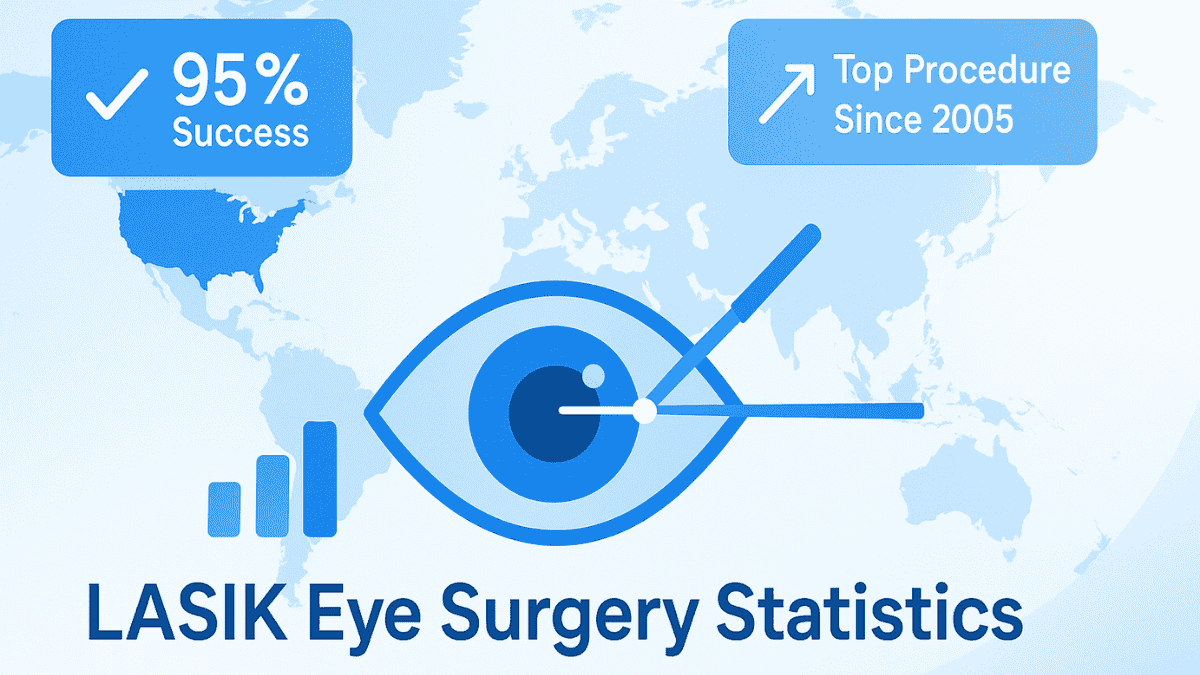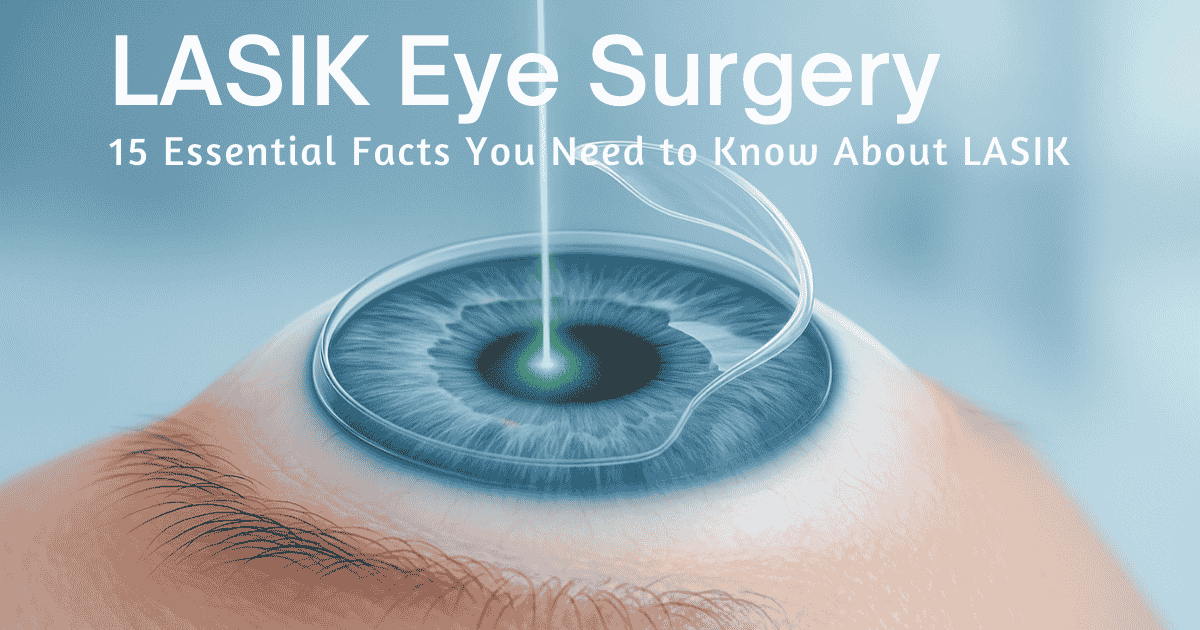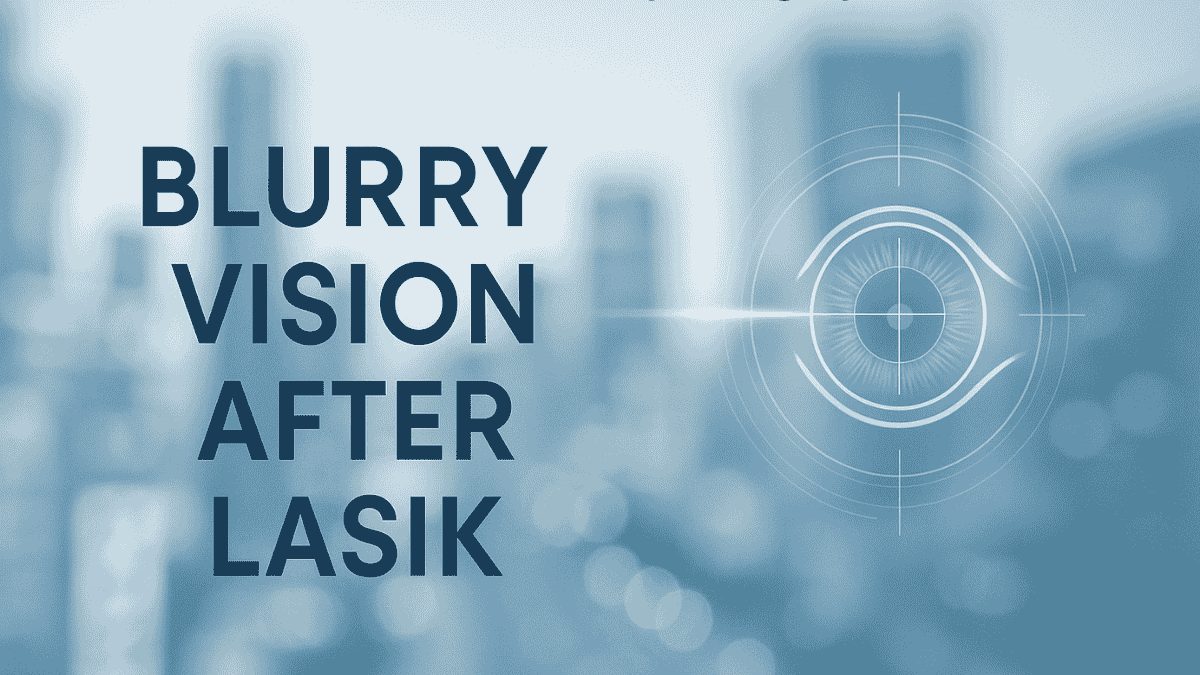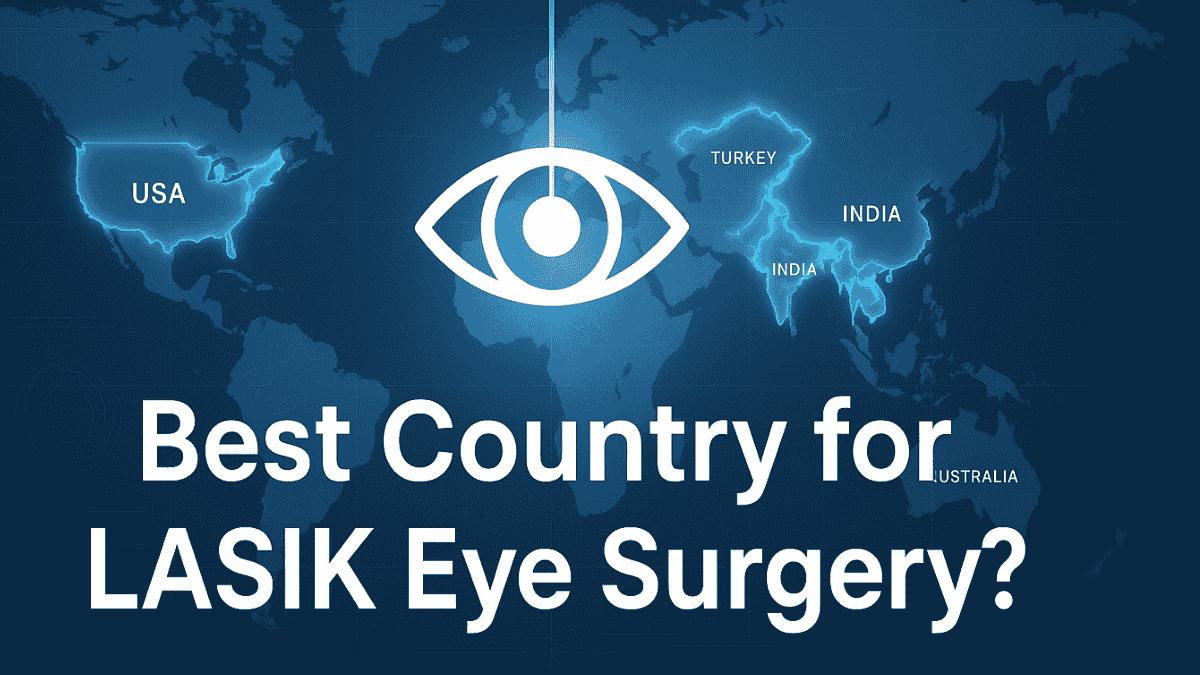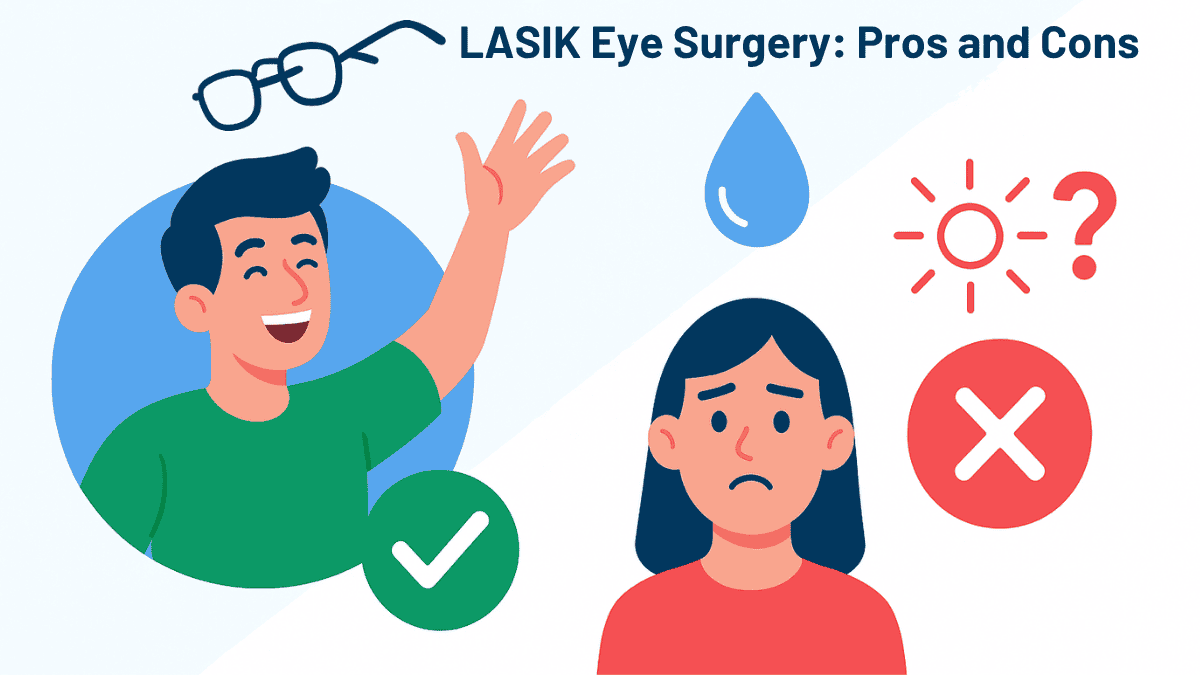
Thinking about LASIK eye surgery? You’re not alone. Many people dream of waking up with clear vision, free from the daily hassle of glasses or contact lenses. But like any medical procedure, weighing the full picture of the pros and cons of LASIK is very important before you make a choice. This article will explore how laser in-situ keratomileusis (LASIK) can be a game-changer for some, while for others, it might present challenges or not be a good option. This honest look at the pros and cons of LASIK aims to give you the clarity you need to decide if it’s the right path for your eyes and general health in 2025.
Table of Contents:
- The Bright Side: Advantages of LASIK Eye Surgery
- Weighing the Risks: Disadvantages of LASIK
- Who Might Want to Pause Before Considering LASIK?
- LASIK Compared: What About Other Vision Correction Options?
- Real Stories: What Patients Say About Their LASIK Experience
- Quick View: LASIK Pros and Cons at a Glance
- Conclusion
The Bright Side: Advantages of LASIK Eye Surgery
The biggest draw of this type of laser surgery is quite clear: significantly improved vision. Imagine seeing the alarm clock clearly when you wake up or recognizing a friend from across the street without squinting. For many, this improvement in sight dramatically boosts their overall quality of life and helps correct refractive errors. This commonly performed refractive surgery has a high success rate in helping people reduce or eliminate their need to wear glasses or contact lenses.
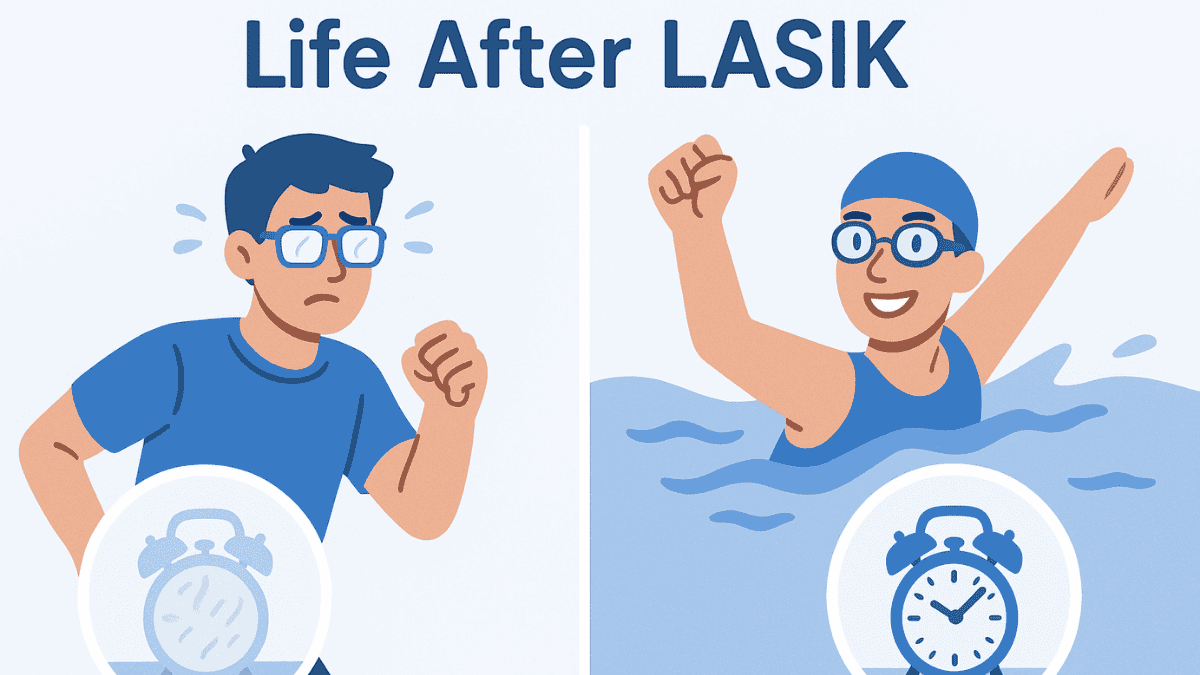
Activities like swimming, playing sports, or even just enjoying a rainy day become simpler without glasses fogging up or contact lenses causing irritation. Beyond just seeing better, there’s a wonderful sense of freedom that comes with LASIK, a key reason people choose this surgical procedure. Say goodbye to the endless cycle of buying new glasses, prescription eye drops for contacts, and contact lens supplies, which can add to the long-term surgery cost benefits.
No more worrying about broken frames or losing a contact lens at the worst possible moment. This newfound independence is a huge plus for active individuals and anyone tired of the daily upkeep vision aids need. Good candidates often find this freedom transformative, especially if they previously struggled with vision problems that impacted their daily routines. The convenience offered by LASIK surgery is a major selling point for many.
Worried about things going wrong? It’s natural to feel that way. But patient satisfaction with LASIK is generally very high, often reported above 95%. Modern LASIK techniques, performed by a skilled eye surgeon at a reputable eye center, have become quite refined, leading to a low rate of serious complications or vision loss.
While no surgery has zero surgery risk, the safety profile of LASIK has improved significantly over the years, making it a good choice for many. Compared to some older vision correction surgeries, LASIK often boasts a quicker recovery period and healing time. Many people notice improved vision almost immediately after the procedure, or within 24 to 48 hours.
While there’s a healing process, you can typically get back to most of your normal activities fairly quickly. This is a big difference from procedures like PRK, which can have a longer and sometimes more uncomfortable initial healing phase. The speed of visual recovery is a significant advantage, allowing individuals to enjoy their corrected vision sooner.
Now, let’s talk money. While the upfront surgery cost of LASIK can seem like a lot, think about the long run. Add up what you spend on glasses, prescription sunglasses, contact lenses, and cleaning solutions over ten, twenty, or even thirty years. For many, LASIK can actually save money over time, even if insurance plans typically don’t cover this permanent surgical procedure. It’s an investment in your vision that can pay off financially, as well as in convenience and quality of vision care.
Related Article
LASIK Eye Surgery Success StatisticsWeighing the Risks: Disadvantages of LASIK
It’s really important to understand that LASIK isn’t without its downsides and potential LASIK cons. One of the most common side effects is dry eyes. This happens because the procedure, where a flap created in the cornea can temporarily affect nerve function, reducing tear production.
For most folks, this is a temporary issue, manageable with lubricating eye drops, but for some, it can become a more persistent problem, sometimes severe enough to include dry eyes as a long-term concern. If you already struggle with dry eyes, LASIK might make it worse, and this is a critical point to discuss during your LASIK consultation. Proper eye care post-surgery is vital to manage this.
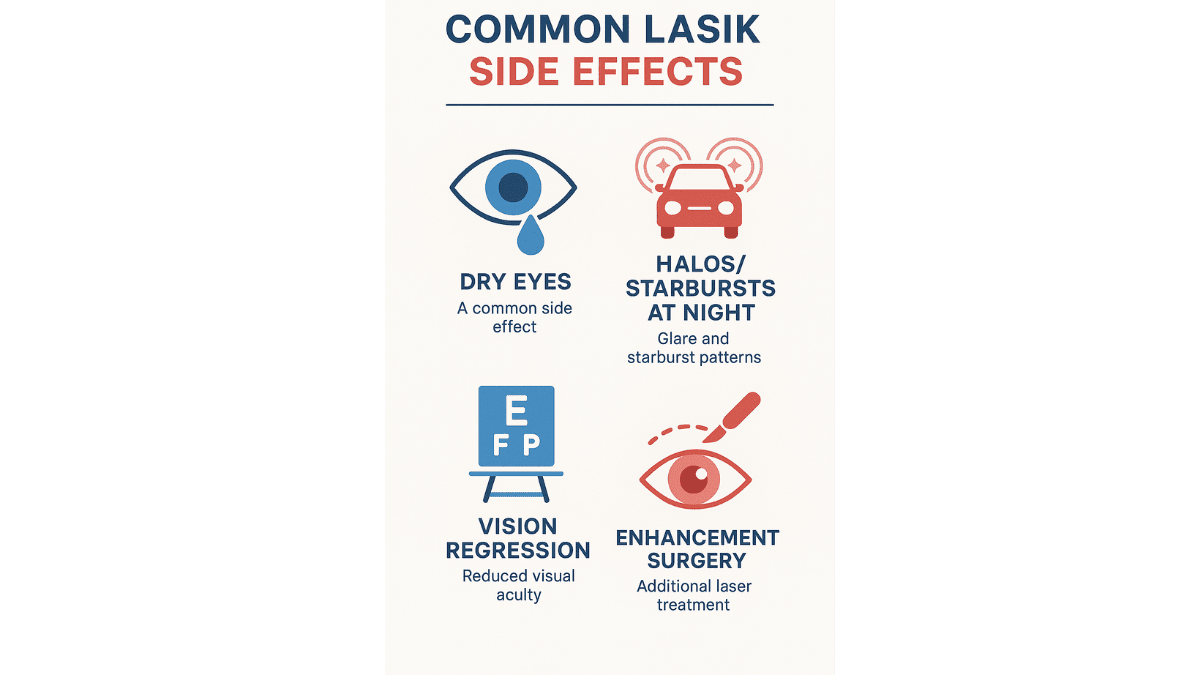
Have you heard people talk about seeing halos around lights or experiencing glare, especially at night? These are other potential side effects that can contribute to worse vision in low light. You might notice starbursts around headlights or streetlights, which can make night driving a bit tricky for a while after the laser eye surgery.
These symptoms usually lessen over time, but in some cases, they can be long-lasting and affect vision quality. Uneven tissue removal, though rare with modern technology, could also contribute to such visual disturbances. These potential issues are part of the surgery risk profile.
Another thing to keep in mind is that your vision can change over time, even after LASIK. This is called regression, and it means your eyesight might gradually shift back towards its original refractive error, or develop new issues like presbyopia (age-related farsightedness) which LASIK doesn’t prevent. This potential for vision change could mean you might need to wear glasses or contact lenses again years down the road, or even consider additional surgery.
Sometimes, the first LASIK procedure doesn’t quite achieve the desired vision correction. In such cases, a LASIK enhancement, which is a follow-up surgical procedure, might be necessary and require additional tissue removal. While often included in the initial cost by some clinics, it’s still another procedure to go through, adding to the overall healing time.
Understanding the possibility of needing an enhancement, and discussing flap complications, is part of seeing the whole picture of this refractive surgery. Unfortunately, LASIK isn’t a good fit for everyone. Certain eye conditions, like very thin corneas, severe dry eye syndrome, active corneal disease, keratoconus, or uncontrolled glaucoma, can make LASIK too risky.
Your overall general health and even certain medical conditions or medications can also play a role. A thorough screening by an experienced eye surgeon is essential to determine if you’re a good candidate for this commonly performed procedure. Issues like uneven tissue in the cornea might also disqualify a candidate.
And yes, the upfront cost we mentioned as a potential long-term benefit can also be a short-term disadvantage. LASIK surgery isn’t usually covered by most insurance plans or a standard vision care plan because it’s considered elective. So, you’ll need to be prepared for the out-of-pocket expense, which can be significant. Financing options are often available, but it’s a cost you need to plan for, and it’s a key part of considering the pros and cons of LASIK.
Related Article
Common Risks of LASIK Eye SurgeryWho Might Want to Pause Before Considering LASIK?
If you have certain pre-existing eye conditions, LASIK might not be your best option. Conditions like advanced glaucoma, cataracts (though this is a separate issue typically addressed by different surgery, sometimes involving an intraocular lens), or corneal diseases such as keratoconus often mean LASIK is off the table. It’s crucial to have healthy eyes before undergoing any laser eye procedure.
Active eye infections or inflammation would also need to be resolved first. People with a history of certain autoimmune diseases like Sjogren’s syndrome, rheumatoid arthritis, or lupus may also have a higher risk of complications, including dry eyes, so a careful discussion with your doctor and eye surgeon is vital. These medical conditions can affect healing and outcomes.
Your prescription eye needs also need to be stable. If your glasses or contact lens prescription has been changing frequently, say every year, you’ll likely be advised to wait. LASIK aims to correct refractive errors like nearsightedness (including moderate nearsightedness) or farsightedness, but it doesn’t stop your eyes from changing naturally, especially your natural lens as you age.
Most surgeons look for a stable prescription for at least a year or two before considering you for the procedure. This is especially true for younger patients whose eyes may still be developing. Attempting to correct an unstable refractive error can lead to unsatisfactory long-term results and potential vision problems.
It’s also important to have realistic expectations. While LASIK can produce amazing results, aiming for “perfect” vision might lead to disappointment. The goal is to reduce your dependence on glasses or when you wear contact lenses significantly, and many people achieve 20/20 vision or better.
But factors like your age (older adults might have different considerations), the complexity of your prescription, and your general health can influence the outcome. It’s a big improvement and often a good choice, but not always absolute perfection for every single person. A thorough LASIK consultation will help set these expectations.
LASIK Compared: What About Other Vision Correction Options?
When looking at vision correction, LASIK is a popular name, but it’s not the only player in the game. Understanding how it stacks up against other procedures, such as those involving an implantable collamer lens or even a refractive lens exchange for certain candidates, can help you make a more informed choice about your eye care. Let’s look at a few comparisons for correcting vision problems.
PRK vs. LASIK: The Flapless Alternative
Photorefractive Keratectomy (PRK) was actually the first type of laser eye surgery, predating LASIK. The main difference is that PRK doesn’t involve creating a corneal flap like LASIK does. Instead, the surgeon removes the outer layer of the cornea (epithelium) and then reshapes the underlying corneal tissue with the laser.
Because there’s no flap, PRK eliminates any risk of flap-related complications, which is a significant point in its favor for some. This makes PRK a potentially better option or good option for people with thin corneas, very dry eyes, or those involved in high-contact sports where a flap created during LASIK could be dislodged. Those with generally healthy eyes but specific corneal concerns might be guided towards PRK.
However, the recovery from PRK is generally longer and can be more uncomfortable than LASIK. Vision also tends to clear up more gradually over weeks or even months, compared to the often rapid improvement seen with LASIK. Both laser procedures have high success rates for vision correction, but the journey and who they suit best can differ significantly.
Related Article
What to Know About PRK SurgerySMILE vs. LASIK: A Newer Contender
SMILE, which stands for Small Incision Lenticule Extraction, is a more recent advancement in laser vision correction. With SMILE, the eye surgeon uses a femtosecond laser to create a small, lens-shaped piece of tissue (lenticule) within the cornea. This lenticule is then removed through a tiny incision, changing the cornea’s shape and helping to correct nearsightedness and astigmatism.
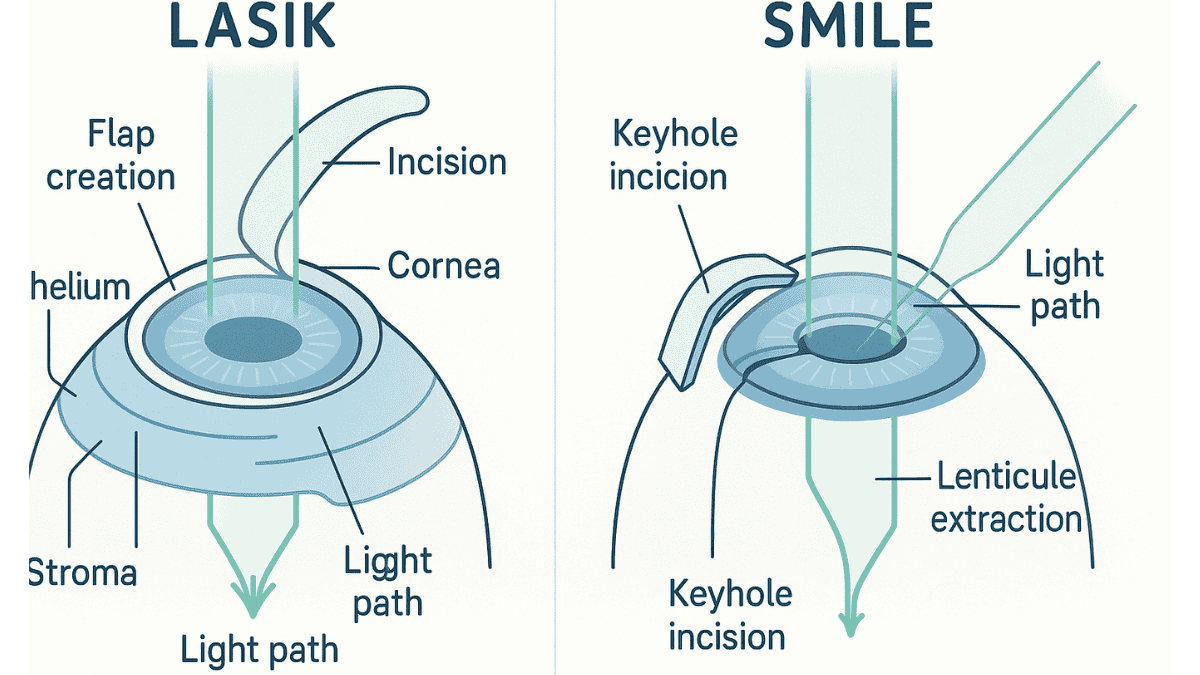
The main advantage touted for SMILE is that it’s less invasive than LASIK because the incision is much smaller, and no flap is created. This could mean a lower risk of issues including dry eyes and faster healing of corneal nerves. Some studies suggest it might be a good choice for those prone to dry eye, a common LASIK con.
But, SMILE is still newer technology. It’s currently best suited for correcting nearsightedness, with or without astigmatism, but may not be as versatile as LASIK for all types of prescriptions, like farsightedness. Research is ongoing, but it’s an interesting alternative for vision correction for good candidates.
Related Article
SMILE Laser Eye Surgery OverviewLASIK vs. Contact Lenses & Glasses: The Daily Grind
This is often the core comparison for many people: the one-time surgical procedure of LASIK versus the ongoing use of glasses or contact lenses. Glasses are simple and safe, but they can be inconvenient if you need to wear glasses constantly. They fog up, get smudged, can break, and might limit your field of vision or get in the way during sports. They also need to be updated as your prescription changes or if you experience vision change.
Contact lenses offer more freedom than glasses, but they come with their own set of responsibilities and risks. There’s the daily routine of cleaning and disinfecting, the cost of lenses and solutions, and the potential for discomfort, allergies, or dry eyes, a problem some hope laser surgery will solve. Those who wear contact lenses for long periods may also experience other eye health issues.
More seriously, improper contact lens care can lead to eye infections, some of which, according to the Centers for Disease Control and Prevention (CDC), can be quite severe and even threaten vision. LASIK aims to remove these daily hassles and potential long-term risks associated with contact lens wear, although it introduces its own set of considerations for your eye care. Many people find the freedom from having to wear contact or glasses liberating.
Related Article
LASIK vs Glasses: Pros and ConsHere’s a simple table comparing these three laser procedures:
| Feature | LASIK (Laser In-Situ Keratomileusis) | PRK (Photorefractive Keratectomy) | SMILE (Small Incision Lenticule Extraction) |
|---|---|---|---|
| Corneal Flap | Yes, a flap created | No | No (small incision for lenticule removal) |
| Recovery Time | Faster (1-2 days for basic vision) | Slower (days to weeks for basic vision, months for full stabilization) | Fast, similar to LASIK, good healing time |
| Dry Eye Risk | Moderate (often temporary, can include dry eyes) | Lower initially, but can still occur | Potentially Lower |
| Suitable For | Nearsightedness, Farsightedness, Astigmatism (to correct refractive errors) | Nearsightedness, Farsightedness, Astigmatism (good for thin corneas, contact sports, healthy eye candidates) | Primarily Nearsightedness (with or without astigmatism, helps correct nearsightedness) |
| Invasiveness | More (due to flap) | Surface ablation (less invasive than flap) | Least invasive (keyhole approach) |
Each option, including other refractive surgery like refractive lens exchange (replacing the natural lens) or an implantable collamer lens (an additive lens), has its place. The best one for you depends heavily on your individual eye health, your specific refractive error, lifestyle, and what you hope to achieve from the vision care procedure. A discussion about your care plan with a specialist at an eye center is crucial.
Real Stories: What Patients Say About Their LASIK Experience
Hearing from people who’ve actually had LASIK, a commonly performed refractive surgery, can give you a different perspective. Of course, everyone’s experience is personal. But, common themes do emerge from those who have undergone this laser surgery.
Many patients are absolutely thrilled with their results. They talk about the joy of waking up and seeing clearly for the first time in years, or the convenience of not having to fumble for glasses. One person might say, “LASIK was life-changing. I can swim, travel, and just live without constantly thinking about my vision problems. I wish I’d done it sooner.” For these individuals, the freedom from needing to wear contact lenses and improved quality of life far outweigh any minor or temporary side effects.
Then there are those who, while generally satisfied, might have had a rockier road or didn’t achieve the “perfect” vision they hoped for after their surgery LASIK. Someone might share, “My vision is much better, and I don’t need glasses for most things. But I do have some lingering dry eye, especially in the winter, and night driving is still a bit challenging with the halos.” These stories remind us that while serious complications like significant vision loss are rare, common side effects can be a real part of the experience for some.
And, it’s important to acknowledge that a small percentage of patients do have regrets or experience more significant, lasting issues. You might hear from someone who says, “I wasn’t fully prepared for how bad the dry eyes would be, and they haven’t gone away. Or my night vision is permanently worse, and it impacts my daily life.” These experiences, though less common, highlight why it’s so vital to understand all potential outcomes, including the risk of requiring additional surgery or experiencing flap complications, and discuss your specific risks with an eye surgeon. The goal of sharing these varied experiences is to provide a balanced view as you consider the overall pros and cons of LASIK.
Quick View: LASIK Pros and Cons at a Glance
If you’re looking for a fast rundown of what LASIK surgery entails, here’s a simple table summarizing the main points:
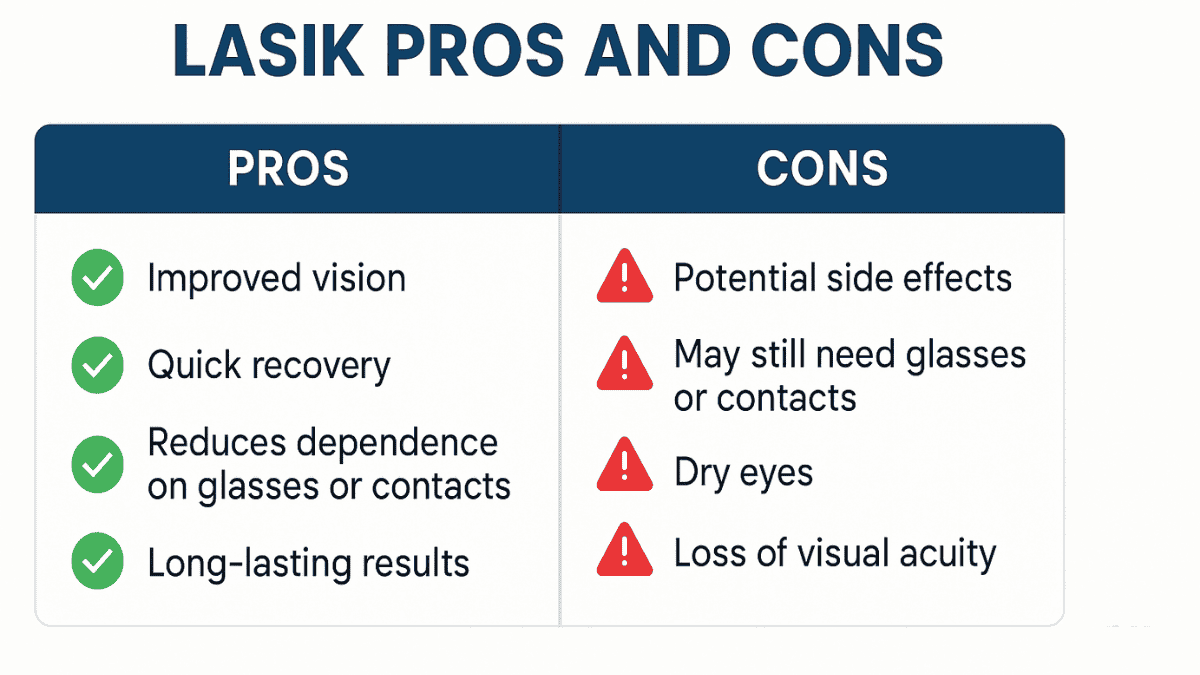
| Pros of LASIK | Cons of LASIK (lasik cons) |
|---|---|
| Significantly improved vision, often 20/20 or better to correct refractive errors. | Potential for dry eyes, sometimes persistent, may include dry. |
| Freedom from glasses and contact lenses (no longer need to wear contact). | Risk of night vision issues (glare, halos, starbursts) leading to worse vision in dim light. |
| Quick visual recovery for many patients, good healing time. | Possibility of vision regression over time or vision change. |
| High patient satisfaction rates for this laser eye surgery. | May need an enhancement surgery or additional surgery. |
| Proven permanent surgical procedure with a long track record. | Not suitable for everyone (due to eye health, prescription eye issues, medical conditions). |
| Potential long-term cost savings compared to glasses/contacts (despite initial surgery cost). | Upfront cost can be high; not usually covered by insurance plans or vision care plan. |
| Fast procedure, typically under 30 minutes for both eyes at an eye center. | Flap-related complications, though rare (e.g., issues with flap created, uneven tissue removal). |
This table gives you a snapshot, but the impact of each point can vary a lot from person to person. Your general health and specific eye conditions play a big role in the outcome.
Conclusion
Deciding whether LASIK eye surgery is right for you is a big step, and it’s a deeply personal choice. There’s no single right answer for everyone considering this form of vision correction. Understanding the many pros and cons of LASIK thoroughly is the most important thing you can do before proceeding with any surgical procedure.
Think about your lifestyle, your tolerance for potential side effects like dry eye, your financial situation, and your vision goals. The next, and really essential, step is to schedule a LASIK consultation with a qualified and experienced LASIK surgeon. They can perform a comprehensive eye exam, discuss your specific eye health, check if you are a good candidate with healthy eyes, and give you a realistic picture of what LASIK might achieve for you. This includes outlining the particular benefits and risks relevant to your eyes and addressing any concerns about vision loss or other surgery risk factors.
Don’t hesitate to ask lots of questions; a good eye surgeon will want you to feel fully informed and comfortable before you make any decisions about your eye care. Ultimately, knowledge is power when it comes to your health and your vision care. Making an informed choice will help you feel confident in your decision regarding this popular laser eye surgery.
LASIK offers fast visual recovery, freedom from glasses or contacts, and long-term cost savings. Many patients achieve 20/20 vision or better.
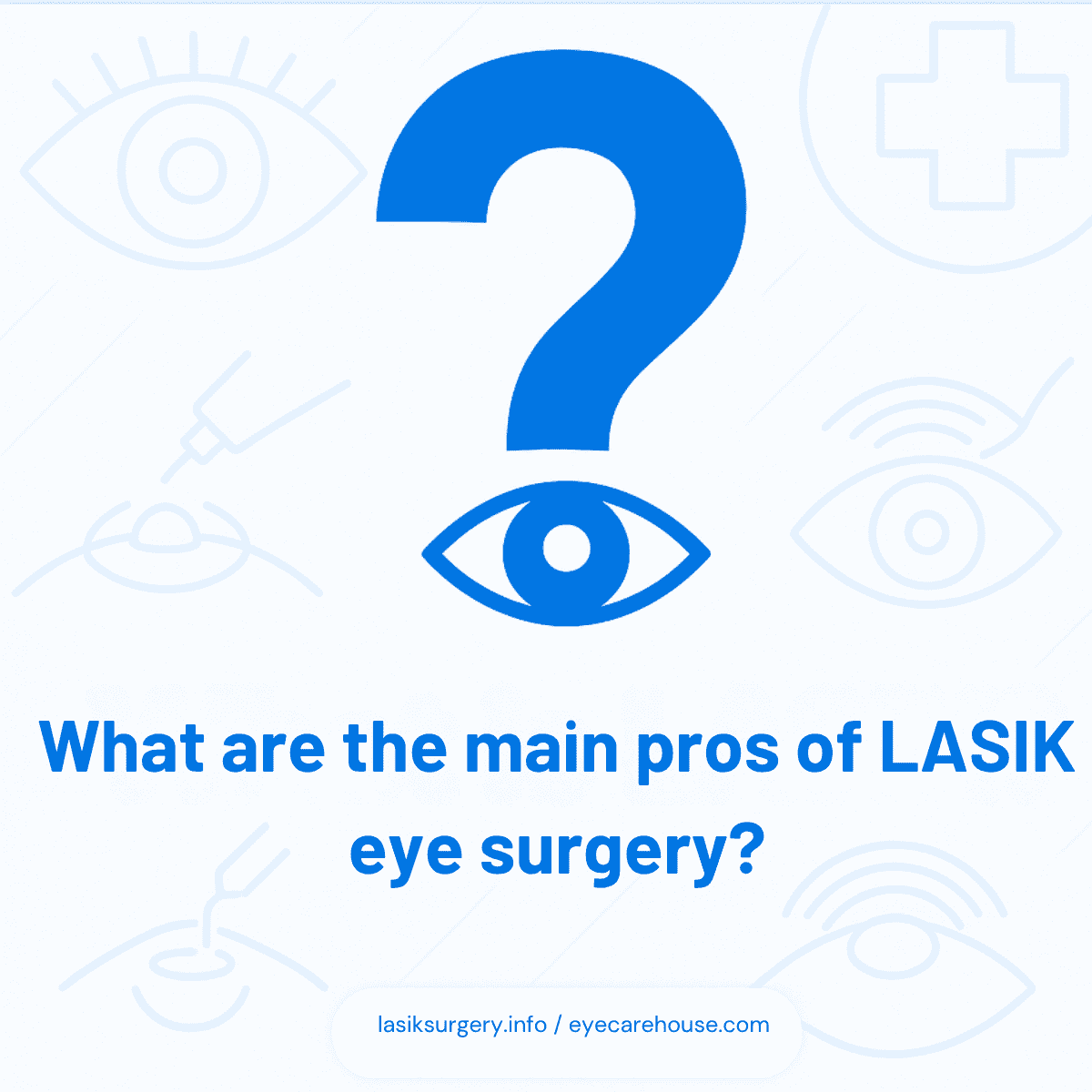
Common LASIK side effects include temporary dry eyes, night vision issues like halos, and in some cases, vision regression or need for enhancements.
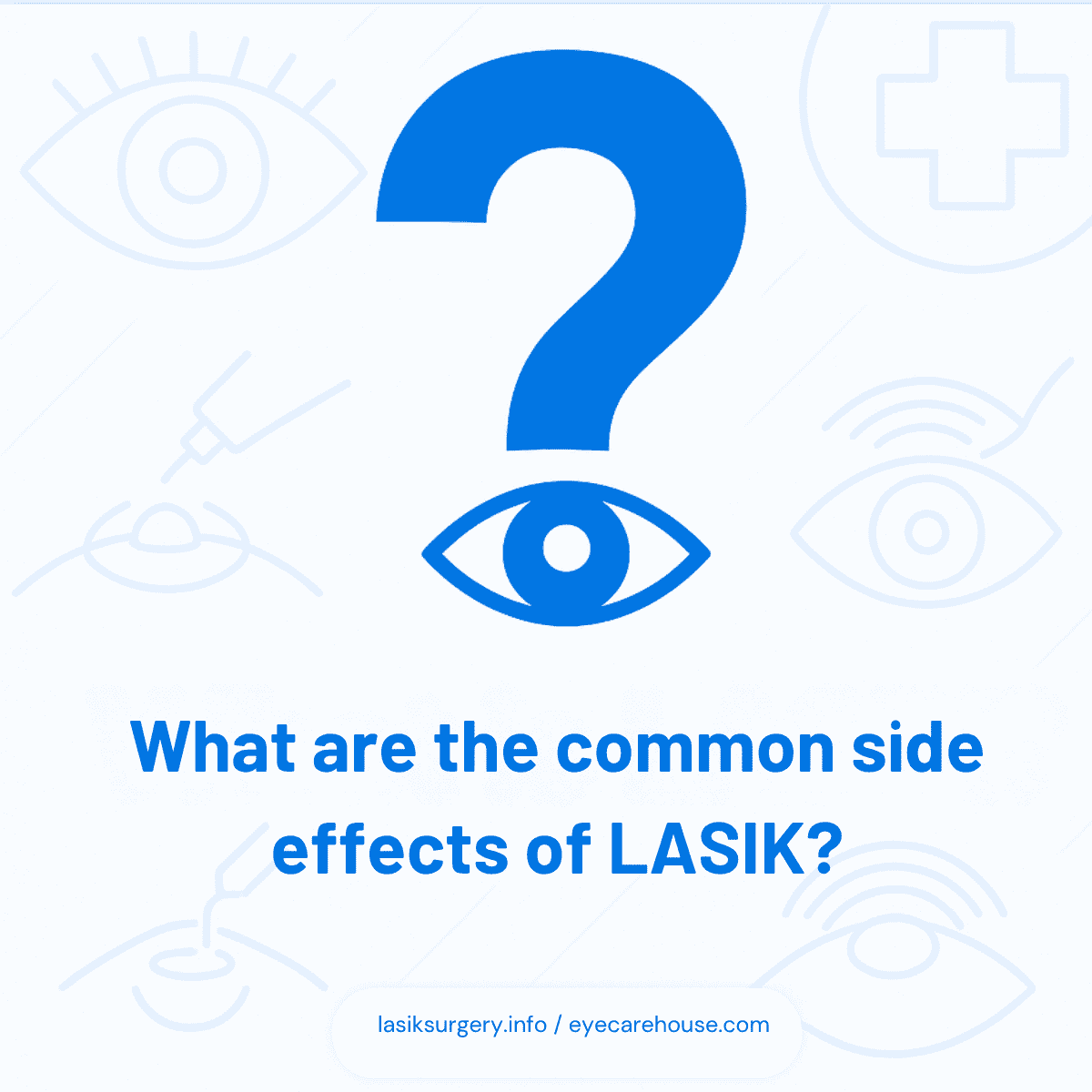
No, LASIK is not ideal for people with unstable prescriptions, thin corneas, or certain eye or autoimmune conditions. A detailed consultation is essential.
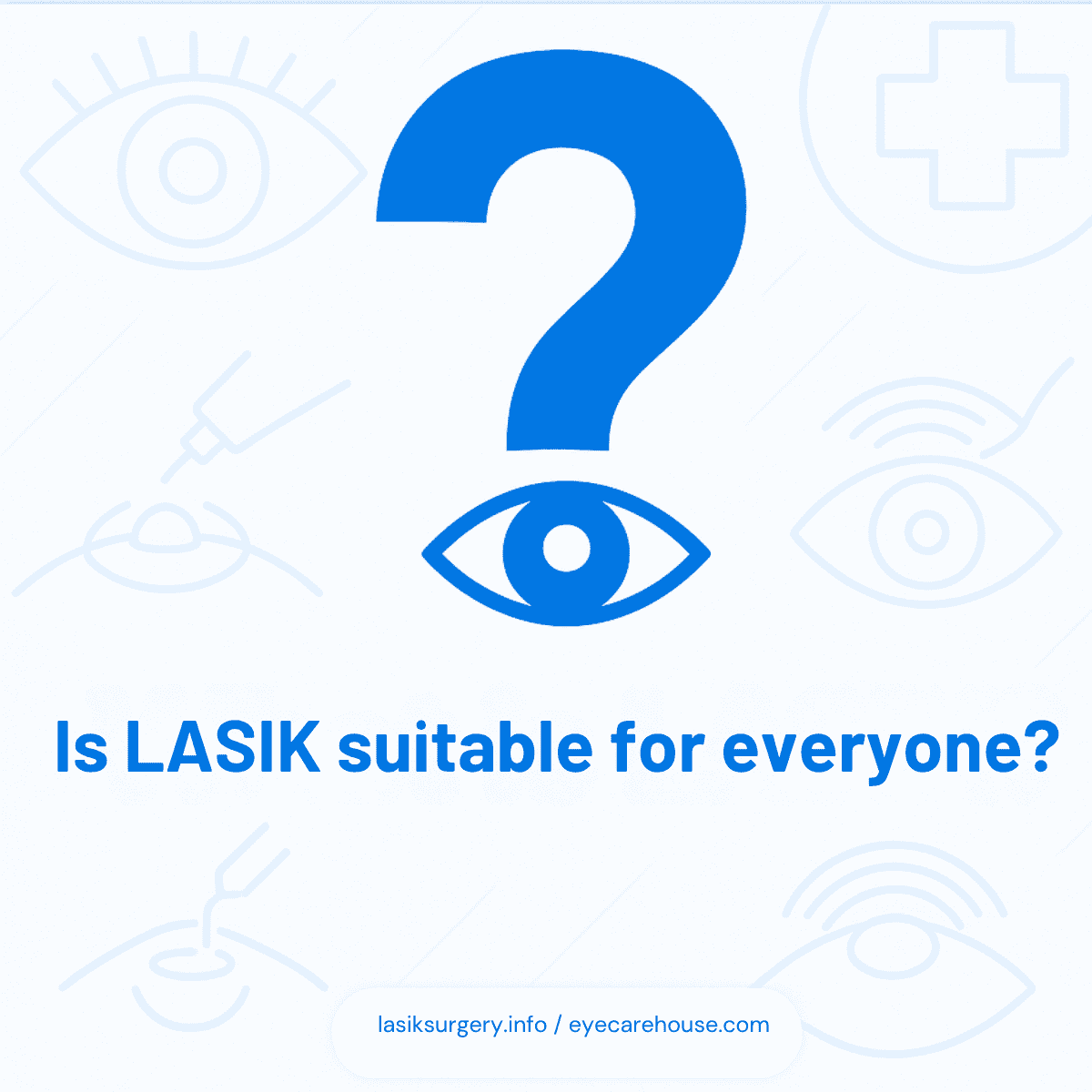
While LASIK offers quicker recovery, PRK avoids flap complications and SMILE is less invasive. Suitability depends on individual eye health and lifestyle.
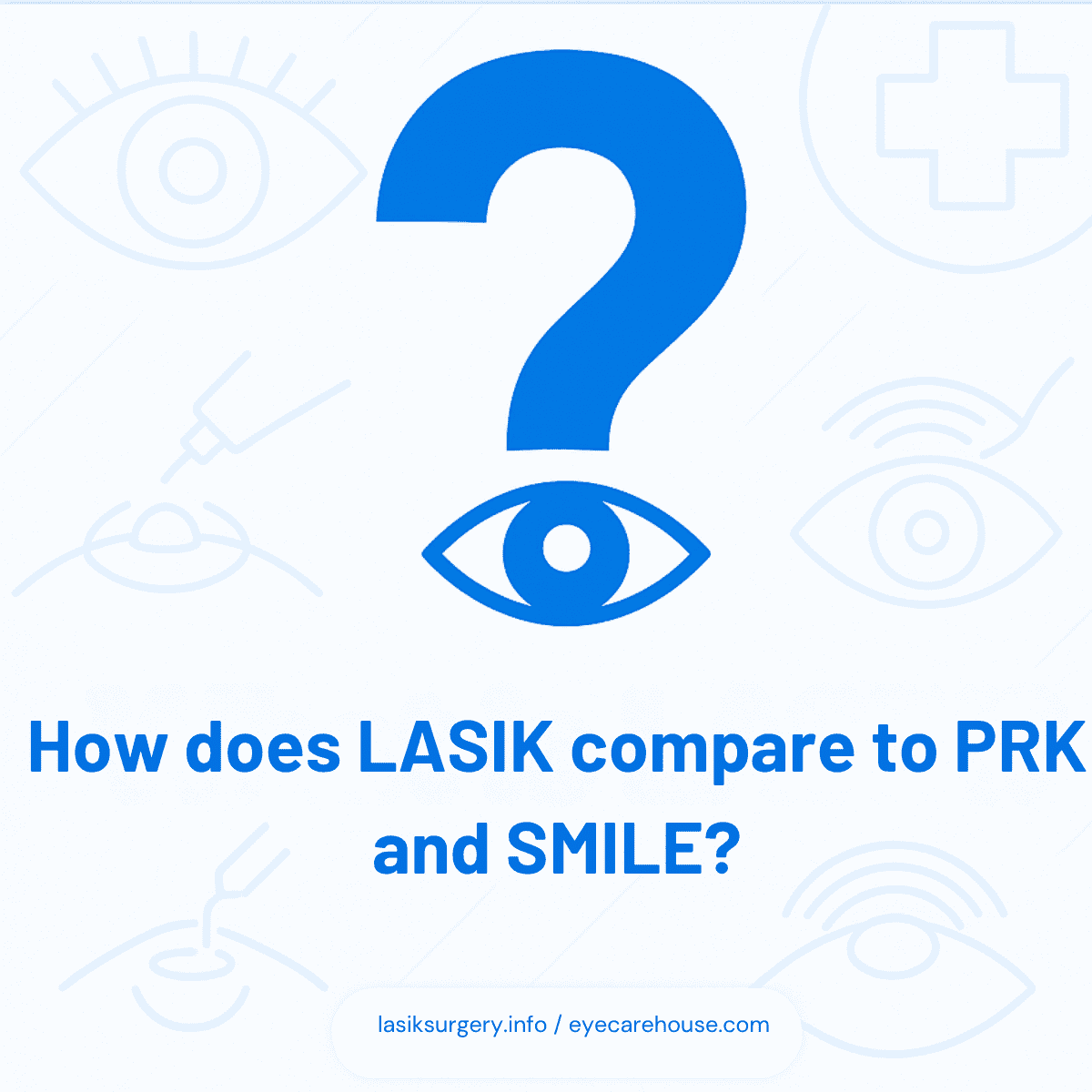
Yes, in some cases, vision regression can occur due to age or natural eye changes. Some patients may need enhancements years later.



